BULAW3731 Taxation Law Report: Sharing Economy and Tax Consequences
VerifiedAdded on 2022/09/15
|15
|3718
|12
Report
AI Summary
This report delves into the complexities of Australian taxation law, specifically focusing on the rise of the sharing economy and its implications. It begins by defining the sharing economy and contrasting its business model with traditional models, using Uber and taxis as examples. The report then explores the concept of the black economy and its impact on tax revenue, highlighting the key differences between the two business models that affect taxation outcomes. It analyzes the challenges faced by tax administrations in ensuring compliance within the sharing economy, including issues related to identifying taxpayers and assessing income. The report examines the tax consequences under existing Australian tax law, discussing the potential for lower tax revenues and the difficulties in enforcing tax obligations. The report also addresses the complexities of distinguishing between commercial and personal use of assets in the sharing economy and the challenges of applying tax compliance. Overall, the report provides a detailed analysis of the taxation landscape within the sharing economy in Australia.
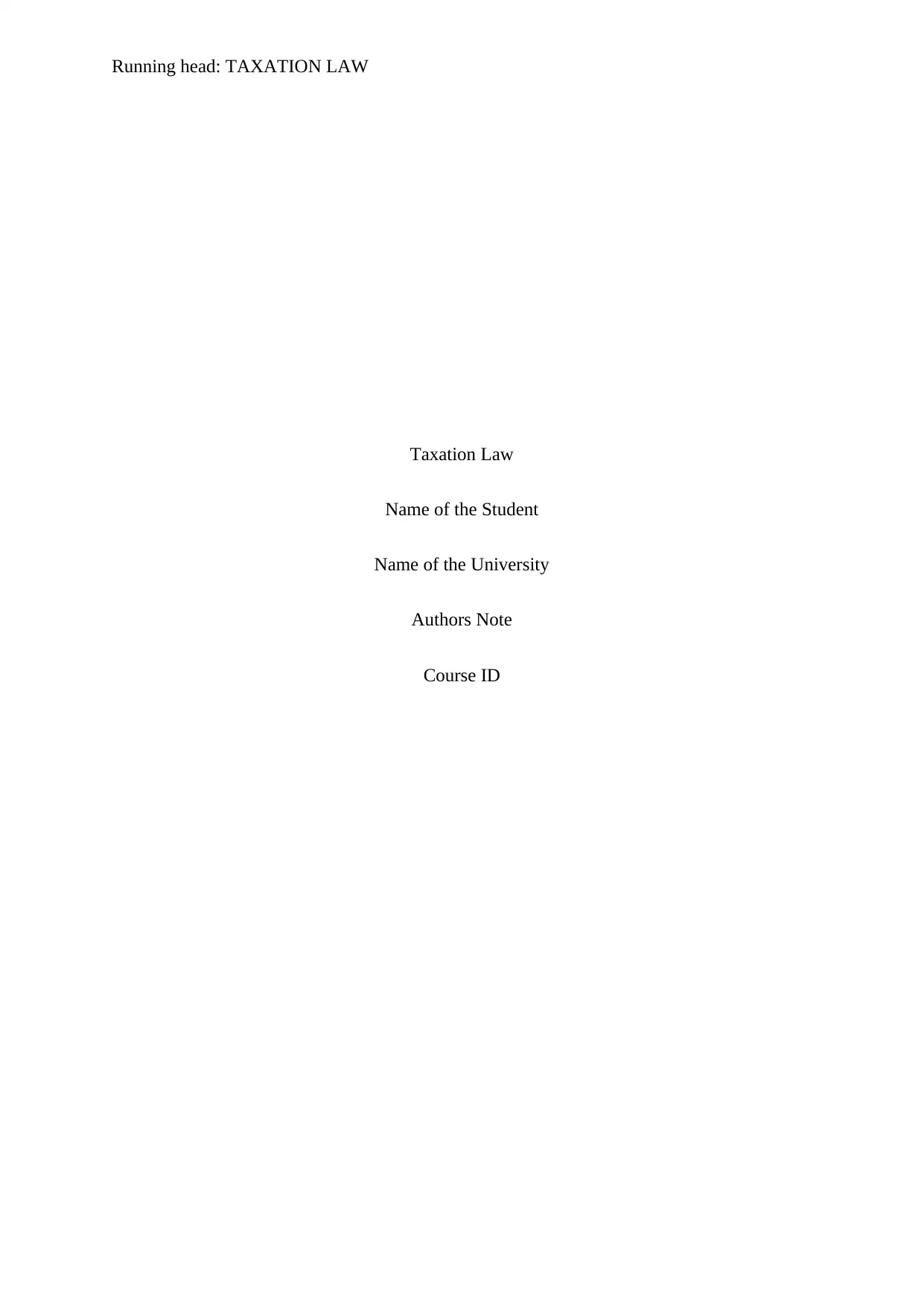
Running head: TAXATION LAW
Taxation Law
Name of the Student
Name of the University
Authors Note
Course ID
Taxation Law
Name of the Student
Name of the University
Authors Note
Course ID
Paraphrase This Document
Need a fresh take? Get an instant paraphrase of this document with our AI Paraphraser

1TAXATION LAW
Executive Summary:
The sharing economy mainly explains the rise of innovative business models that
simply uproots the traditional market, breaks down the categories in industry and makes
optimum use of scarce resources. The study would be highlighting on the sharing economy
business model and the traditional business model. The report would be speaking about the
business structures and the technique of their operations. The report would also deliver the
key changes among the two businesses which might make an impact on the assessment and
tax consequences under the present tax laws in Australia.
Executive Summary:
The sharing economy mainly explains the rise of innovative business models that
simply uproots the traditional market, breaks down the categories in industry and makes
optimum use of scarce resources. The study would be highlighting on the sharing economy
business model and the traditional business model. The report would be speaking about the
business structures and the technique of their operations. The report would also deliver the
key changes among the two businesses which might make an impact on the assessment and
tax consequences under the present tax laws in Australia.
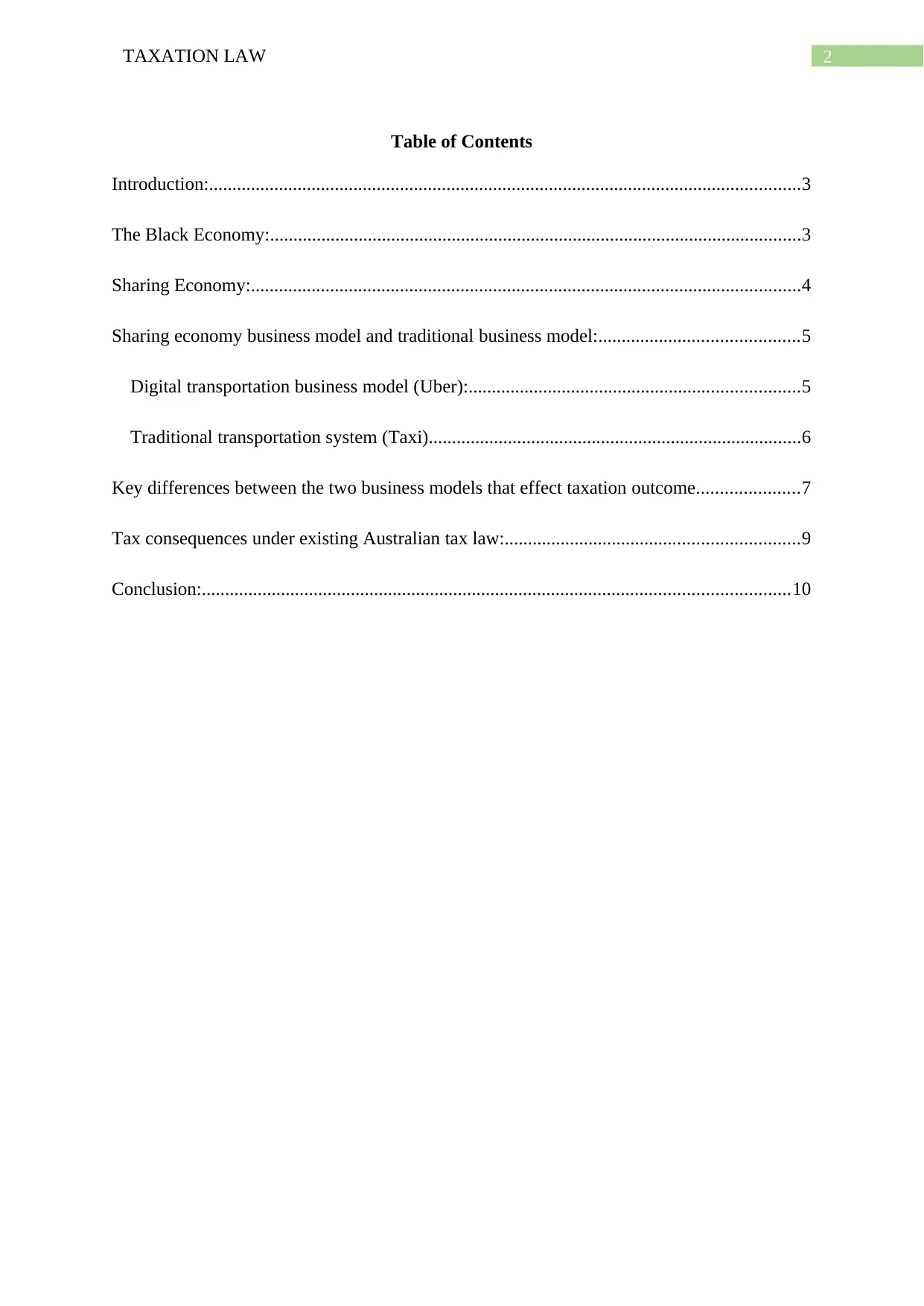
2TAXATION LAW
Table of Contents
Introduction:...............................................................................................................................3
The Black Economy:..................................................................................................................3
Sharing Economy:......................................................................................................................4
Sharing economy business model and traditional business model:...........................................5
Digital transportation business model (Uber):.......................................................................5
Traditional transportation system (Taxi)................................................................................6
Key differences between the two business models that effect taxation outcome......................7
Tax consequences under existing Australian tax law:...............................................................9
Conclusion:..............................................................................................................................10
Table of Contents
Introduction:...............................................................................................................................3
The Black Economy:..................................................................................................................3
Sharing Economy:......................................................................................................................4
Sharing economy business model and traditional business model:...........................................5
Digital transportation business model (Uber):.......................................................................5
Traditional transportation system (Taxi)................................................................................6
Key differences between the two business models that effect taxation outcome......................7
Tax consequences under existing Australian tax law:...............................................................9
Conclusion:..............................................................................................................................10
⊘ This is a preview!⊘
Do you want full access?
Subscribe today to unlock all pages.

Trusted by 1+ million students worldwide

3TAXATION LAW
Introduction:
The digitalization has harnessed increased amount of advantage from the internet
connectivity together with the obtainability of difficult data processing algorithms for
creating an online platform which matches parties that are willing to enter in the sharing
transactions. The business structure of sharing economy has backed to numerous economic,
communal and lawful issues. With the continuous growth in the economy size and broader
marketplace share it creates a pressure on the government for addressing and studying these
issues for redressing the rising distortions, but supporting the progressive innovation as well
(De Groen & Maselli, 2016). The main concern, forming as the core of the current article, is
whether the activities performed by the agents engaged in sharing economy is sufficiently
taken for levying duty. The present position states that the inadequate sharing economy exact
regulations aggravated by unfortunate discernibility of underlying activities leads to lower tax
collection from the final users and tax opportunities for the platform leading to a one-sided
competitive benefit over the competitors under the highly strict organized traditional sectors.
The report would be emphasizing on the business structure of sharing economy and
the traditional business model. The report would be addressing the business structures and the
method of their operations. The report would also provide the key differences among the two
businesses which might create an impact on the taxation and tax consequences inside the
present tax regulations in Australia.
The Black Economy:
Black economy can be defined as the people that operate completely out of the tax
and regulatory structure or those that are known to the establishments but does not rightly
report their duties relating to tax (Joshi et al., 2014). It includes wide-ranging practices,
together with the understatement of the takings, payments as well as receipt of cash pays off
Introduction:
The digitalization has harnessed increased amount of advantage from the internet
connectivity together with the obtainability of difficult data processing algorithms for
creating an online platform which matches parties that are willing to enter in the sharing
transactions. The business structure of sharing economy has backed to numerous economic,
communal and lawful issues. With the continuous growth in the economy size and broader
marketplace share it creates a pressure on the government for addressing and studying these
issues for redressing the rising distortions, but supporting the progressive innovation as well
(De Groen & Maselli, 2016). The main concern, forming as the core of the current article, is
whether the activities performed by the agents engaged in sharing economy is sufficiently
taken for levying duty. The present position states that the inadequate sharing economy exact
regulations aggravated by unfortunate discernibility of underlying activities leads to lower tax
collection from the final users and tax opportunities for the platform leading to a one-sided
competitive benefit over the competitors under the highly strict organized traditional sectors.
The report would be emphasizing on the business structure of sharing economy and
the traditional business model. The report would be addressing the business structures and the
method of their operations. The report would also provide the key differences among the two
businesses which might create an impact on the taxation and tax consequences inside the
present tax regulations in Australia.
The Black Economy:
Black economy can be defined as the people that operate completely out of the tax
and regulatory structure or those that are known to the establishments but does not rightly
report their duties relating to tax (Joshi et al., 2014). It includes wide-ranging practices,
together with the understatement of the takings, payments as well as receipt of cash pays off
Paraphrase This Document
Need a fresh take? Get an instant paraphrase of this document with our AI Paraphraser
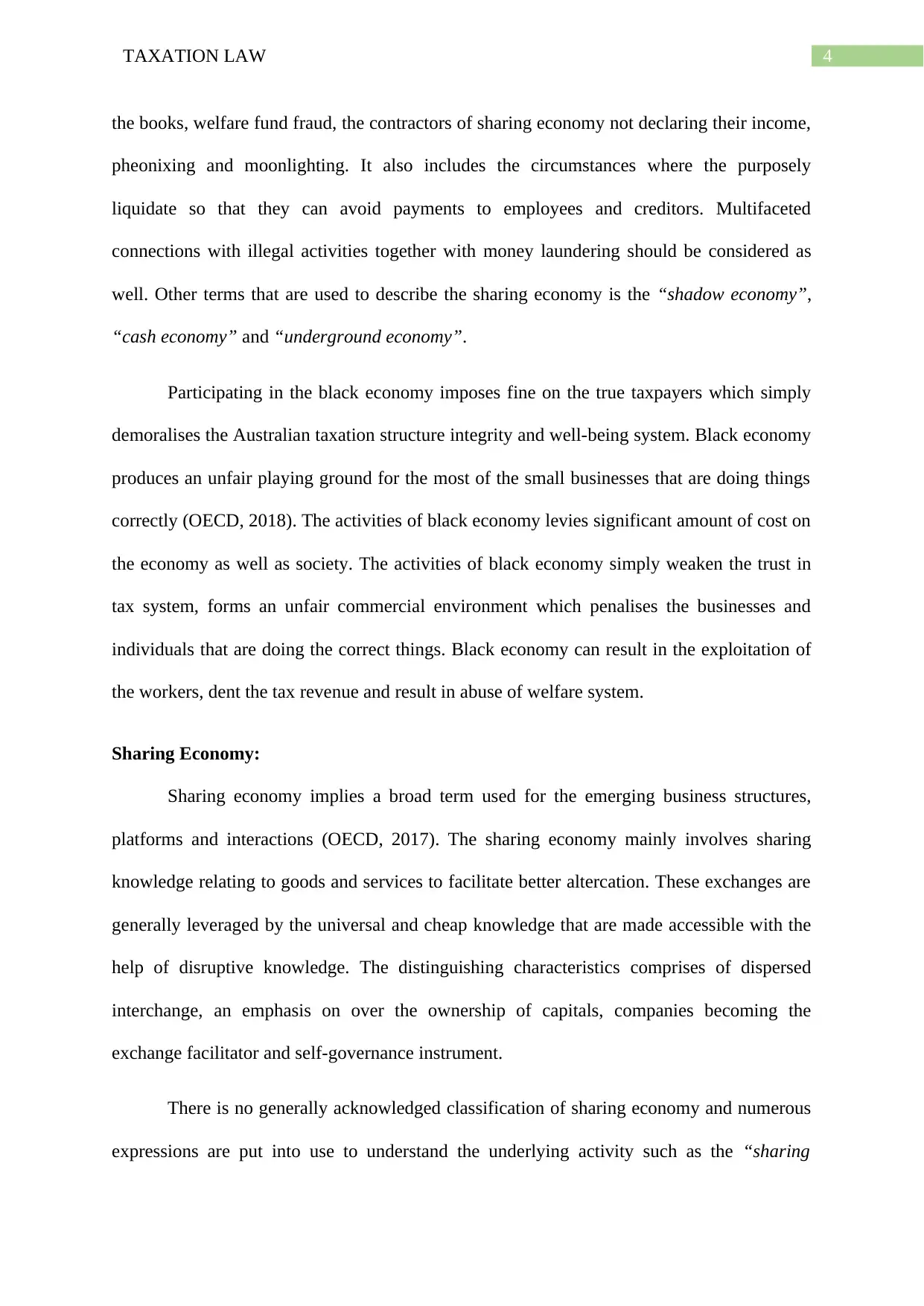
4TAXATION LAW
the books, welfare fund fraud, the contractors of sharing economy not declaring their income,
pheonixing and moonlighting. It also includes the circumstances where the purposely
liquidate so that they can avoid payments to employees and creditors. Multifaceted
connections with illegal activities together with money laundering should be considered as
well. Other terms that are used to describe the sharing economy is the “shadow economy”,
“cash economy” and “underground economy”.
Participating in the black economy imposes fine on the true taxpayers which simply
demoralises the Australian taxation structure integrity and well-being system. Black economy
produces an unfair playing ground for the most of the small businesses that are doing things
correctly (OECD, 2018). The activities of black economy levies significant amount of cost on
the economy as well as society. The activities of black economy simply weaken the trust in
tax system, forms an unfair commercial environment which penalises the businesses and
individuals that are doing the correct things. Black economy can result in the exploitation of
the workers, dent the tax revenue and result in abuse of welfare system.
Sharing Economy:
Sharing economy implies a broad term used for the emerging business structures,
platforms and interactions (OECD, 2017). The sharing economy mainly involves sharing
knowledge relating to goods and services to facilitate better altercation. These exchanges are
generally leveraged by the universal and cheap knowledge that are made accessible with the
help of disruptive knowledge. The distinguishing characteristics comprises of dispersed
interchange, an emphasis on over the ownership of capitals, companies becoming the
exchange facilitator and self-governance instrument.
There is no generally acknowledged classification of sharing economy and numerous
expressions are put into use to understand the underlying activity such as the “sharing
the books, welfare fund fraud, the contractors of sharing economy not declaring their income,
pheonixing and moonlighting. It also includes the circumstances where the purposely
liquidate so that they can avoid payments to employees and creditors. Multifaceted
connections with illegal activities together with money laundering should be considered as
well. Other terms that are used to describe the sharing economy is the “shadow economy”,
“cash economy” and “underground economy”.
Participating in the black economy imposes fine on the true taxpayers which simply
demoralises the Australian taxation structure integrity and well-being system. Black economy
produces an unfair playing ground for the most of the small businesses that are doing things
correctly (OECD, 2018). The activities of black economy levies significant amount of cost on
the economy as well as society. The activities of black economy simply weaken the trust in
tax system, forms an unfair commercial environment which penalises the businesses and
individuals that are doing the correct things. Black economy can result in the exploitation of
the workers, dent the tax revenue and result in abuse of welfare system.
Sharing Economy:
Sharing economy implies a broad term used for the emerging business structures,
platforms and interactions (OECD, 2017). The sharing economy mainly involves sharing
knowledge relating to goods and services to facilitate better altercation. These exchanges are
generally leveraged by the universal and cheap knowledge that are made accessible with the
help of disruptive knowledge. The distinguishing characteristics comprises of dispersed
interchange, an emphasis on over the ownership of capitals, companies becoming the
exchange facilitator and self-governance instrument.
There is no generally acknowledged classification of sharing economy and numerous
expressions are put into use to understand the underlying activity such as the “sharing
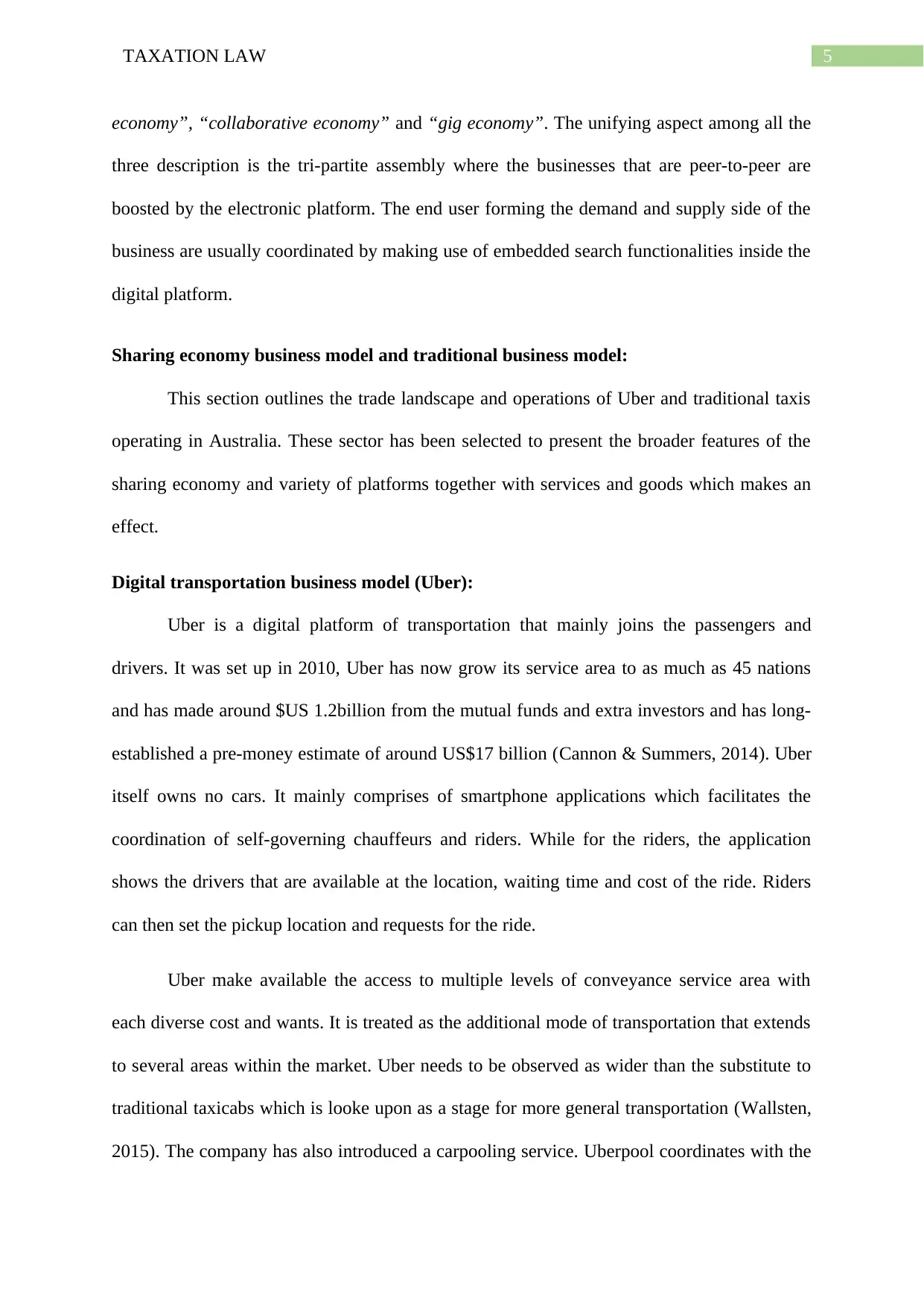
5TAXATION LAW
economy”, “collaborative economy” and “gig economy”. The unifying aspect among all the
three description is the tri-partite assembly where the businesses that are peer-to-peer are
boosted by the electronic platform. The end user forming the demand and supply side of the
business are usually coordinated by making use of embedded search functionalities inside the
digital platform.
Sharing economy business model and traditional business model:
This section outlines the trade landscape and operations of Uber and traditional taxis
operating in Australia. These sector has been selected to present the broader features of the
sharing economy and variety of platforms together with services and goods which makes an
effect.
Digital transportation business model (Uber):
Uber is a digital platform of transportation that mainly joins the passengers and
drivers. It was set up in 2010, Uber has now grow its service area to as much as 45 nations
and has made around $US 1.2billion from the mutual funds and extra investors and has long-
established a pre-money estimate of around US$17 billion (Cannon & Summers, 2014). Uber
itself owns no cars. It mainly comprises of smartphone applications which facilitates the
coordination of self-governing chauffeurs and riders. While for the riders, the application
shows the drivers that are available at the location, waiting time and cost of the ride. Riders
can then set the pickup location and requests for the ride.
Uber make available the access to multiple levels of conveyance service area with
each diverse cost and wants. It is treated as the additional mode of transportation that extends
to several areas within the market. Uber needs to be observed as wider than the substitute to
traditional taxicabs which is looke upon as a stage for more general transportation (Wallsten,
2015). The company has also introduced a carpooling service. Uberpool coordinates with the
economy”, “collaborative economy” and “gig economy”. The unifying aspect among all the
three description is the tri-partite assembly where the businesses that are peer-to-peer are
boosted by the electronic platform. The end user forming the demand and supply side of the
business are usually coordinated by making use of embedded search functionalities inside the
digital platform.
Sharing economy business model and traditional business model:
This section outlines the trade landscape and operations of Uber and traditional taxis
operating in Australia. These sector has been selected to present the broader features of the
sharing economy and variety of platforms together with services and goods which makes an
effect.
Digital transportation business model (Uber):
Uber is a digital platform of transportation that mainly joins the passengers and
drivers. It was set up in 2010, Uber has now grow its service area to as much as 45 nations
and has made around $US 1.2billion from the mutual funds and extra investors and has long-
established a pre-money estimate of around US$17 billion (Cannon & Summers, 2014). Uber
itself owns no cars. It mainly comprises of smartphone applications which facilitates the
coordination of self-governing chauffeurs and riders. While for the riders, the application
shows the drivers that are available at the location, waiting time and cost of the ride. Riders
can then set the pickup location and requests for the ride.
Uber make available the access to multiple levels of conveyance service area with
each diverse cost and wants. It is treated as the additional mode of transportation that extends
to several areas within the market. Uber needs to be observed as wider than the substitute to
traditional taxicabs which is looke upon as a stage for more general transportation (Wallsten,
2015). The company has also introduced a carpooling service. Uberpool coordinates with the
⊘ This is a preview!⊘
Do you want full access?
Subscribe today to unlock all pages.

Trusted by 1+ million students worldwide
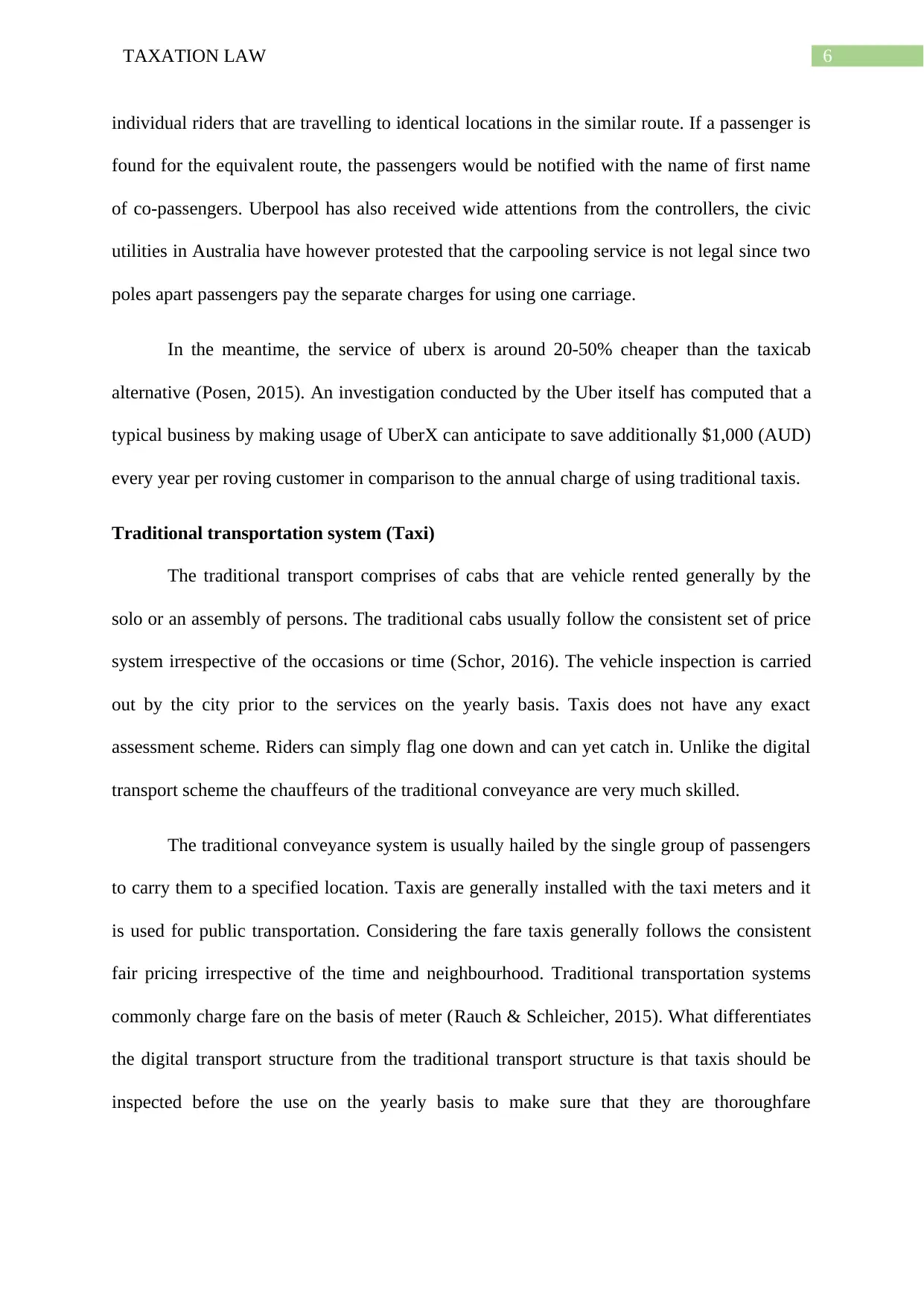
6TAXATION LAW
individual riders that are travelling to identical locations in the similar route. If a passenger is
found for the equivalent route, the passengers would be notified with the name of first name
of co-passengers. Uberpool has also received wide attentions from the controllers, the civic
utilities in Australia have however protested that the carpooling service is not legal since two
poles apart passengers pay the separate charges for using one carriage.
In the meantime, the service of uberx is around 20-50% cheaper than the taxicab
alternative (Posen, 2015). An investigation conducted by the Uber itself has computed that a
typical business by making usage of UberX can anticipate to save additionally $1,000 (AUD)
every year per roving customer in comparison to the annual charge of using traditional taxis.
Traditional transportation system (Taxi)
The traditional transport comprises of cabs that are vehicle rented generally by the
solo or an assembly of persons. The traditional cabs usually follow the consistent set of price
system irrespective of the occasions or time (Schor, 2016). The vehicle inspection is carried
out by the city prior to the services on the yearly basis. Taxis does not have any exact
assessment scheme. Riders can simply flag one down and can yet catch in. Unlike the digital
transport scheme the chauffeurs of the traditional conveyance are very much skilled.
The traditional conveyance system is usually hailed by the single group of passengers
to carry them to a specified location. Taxis are generally installed with the taxi meters and it
is used for public transportation. Considering the fare taxis generally follows the consistent
fair pricing irrespective of the time and neighbourhood. Traditional transportation systems
commonly charge fare on the basis of meter (Rauch & Schleicher, 2015). What differentiates
the digital transport structure from the traditional transport structure is that taxis should be
inspected before the use on the yearly basis to make sure that they are thoroughfare
individual riders that are travelling to identical locations in the similar route. If a passenger is
found for the equivalent route, the passengers would be notified with the name of first name
of co-passengers. Uberpool has also received wide attentions from the controllers, the civic
utilities in Australia have however protested that the carpooling service is not legal since two
poles apart passengers pay the separate charges for using one carriage.
In the meantime, the service of uberx is around 20-50% cheaper than the taxicab
alternative (Posen, 2015). An investigation conducted by the Uber itself has computed that a
typical business by making usage of UberX can anticipate to save additionally $1,000 (AUD)
every year per roving customer in comparison to the annual charge of using traditional taxis.
Traditional transportation system (Taxi)
The traditional transport comprises of cabs that are vehicle rented generally by the
solo or an assembly of persons. The traditional cabs usually follow the consistent set of price
system irrespective of the occasions or time (Schor, 2016). The vehicle inspection is carried
out by the city prior to the services on the yearly basis. Taxis does not have any exact
assessment scheme. Riders can simply flag one down and can yet catch in. Unlike the digital
transport scheme the chauffeurs of the traditional conveyance are very much skilled.
The traditional conveyance system is usually hailed by the single group of passengers
to carry them to a specified location. Taxis are generally installed with the taxi meters and it
is used for public transportation. Considering the fare taxis generally follows the consistent
fair pricing irrespective of the time and neighbourhood. Traditional transportation systems
commonly charge fare on the basis of meter (Rauch & Schleicher, 2015). What differentiates
the digital transport structure from the traditional transport structure is that taxis should be
inspected before the use on the yearly basis to make sure that they are thoroughfare
Paraphrase This Document
Need a fresh take? Get an instant paraphrase of this document with our AI Paraphraser
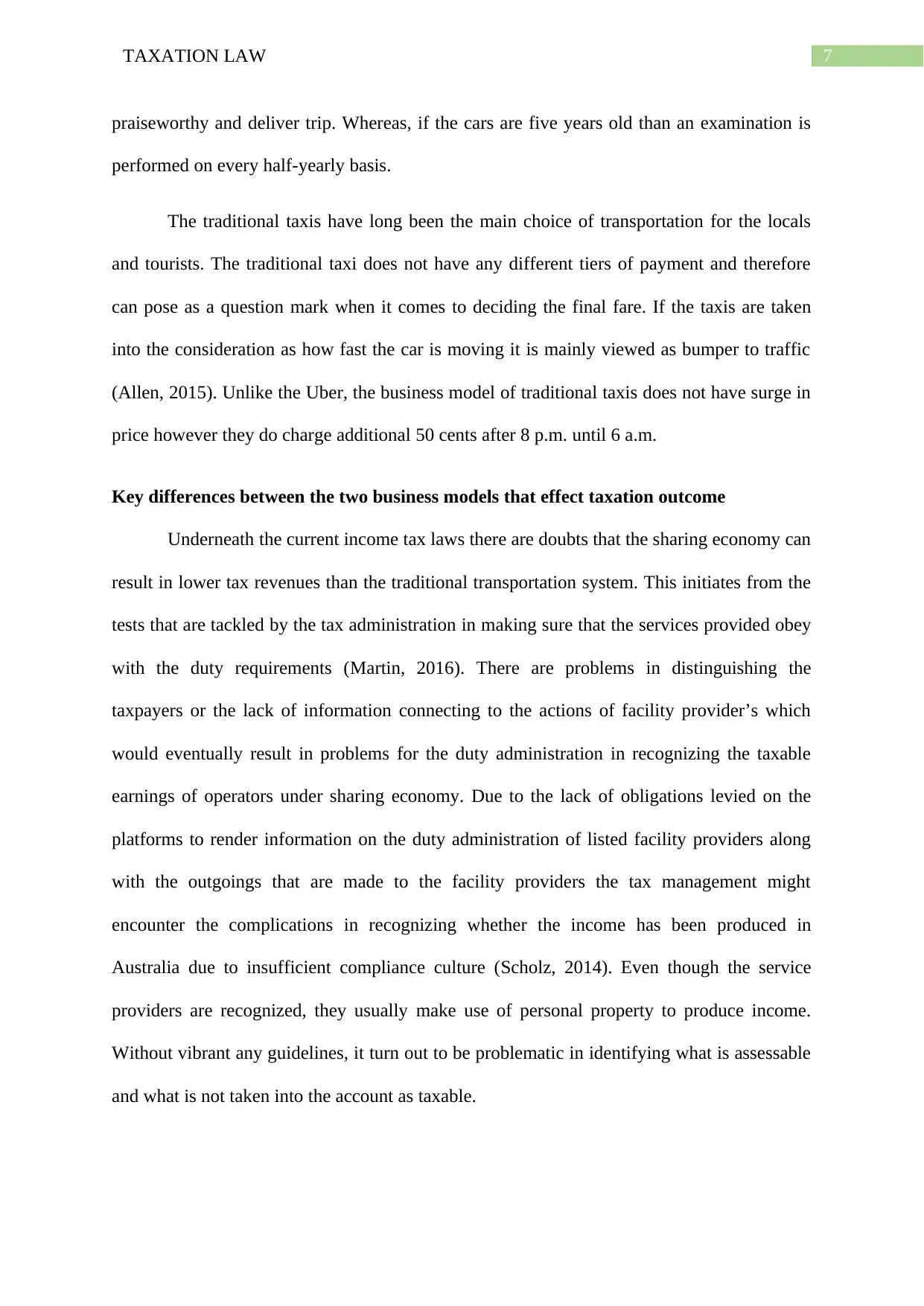
7TAXATION LAW
praiseworthy and deliver trip. Whereas, if the cars are five years old than an examination is
performed on every half-yearly basis.
The traditional taxis have long been the main choice of transportation for the locals
and tourists. The traditional taxi does not have any different tiers of payment and therefore
can pose as a question mark when it comes to deciding the final fare. If the taxis are taken
into the consideration as how fast the car is moving it is mainly viewed as bumper to traffic
(Allen, 2015). Unlike the Uber, the business model of traditional taxis does not have surge in
price however they do charge additional 50 cents after 8 p.m. until 6 a.m.
Key differences between the two business models that effect taxation outcome
Underneath the current income tax laws there are doubts that the sharing economy can
result in lower tax revenues than the traditional transportation system. This initiates from the
tests that are tackled by the tax administration in making sure that the services provided obey
with the duty requirements (Martin, 2016). There are problems in distinguishing the
taxpayers or the lack of information connecting to the actions of facility provider’s which
would eventually result in problems for the duty administration in recognizing the taxable
earnings of operators under sharing economy. Due to the lack of obligations levied on the
platforms to render information on the duty administration of listed facility providers along
with the outgoings that are made to the facility providers the tax management might
encounter the complications in recognizing whether the income has been produced in
Australia due to insufficient compliance culture (Scholz, 2014). Even though the service
providers are recognized, they usually make use of personal property to produce income.
Without vibrant any guidelines, it turn out to be problematic in identifying what is assessable
and what is not taken into the account as taxable.
praiseworthy and deliver trip. Whereas, if the cars are five years old than an examination is
performed on every half-yearly basis.
The traditional taxis have long been the main choice of transportation for the locals
and tourists. The traditional taxi does not have any different tiers of payment and therefore
can pose as a question mark when it comes to deciding the final fare. If the taxis are taken
into the consideration as how fast the car is moving it is mainly viewed as bumper to traffic
(Allen, 2015). Unlike the Uber, the business model of traditional taxis does not have surge in
price however they do charge additional 50 cents after 8 p.m. until 6 a.m.
Key differences between the two business models that effect taxation outcome
Underneath the current income tax laws there are doubts that the sharing economy can
result in lower tax revenues than the traditional transportation system. This initiates from the
tests that are tackled by the tax administration in making sure that the services provided obey
with the duty requirements (Martin, 2016). There are problems in distinguishing the
taxpayers or the lack of information connecting to the actions of facility provider’s which
would eventually result in problems for the duty administration in recognizing the taxable
earnings of operators under sharing economy. Due to the lack of obligations levied on the
platforms to render information on the duty administration of listed facility providers along
with the outgoings that are made to the facility providers the tax management might
encounter the complications in recognizing whether the income has been produced in
Australia due to insufficient compliance culture (Scholz, 2014). Even though the service
providers are recognized, they usually make use of personal property to produce income.
Without vibrant any guidelines, it turn out to be problematic in identifying what is assessable
and what is not taken into the account as taxable.
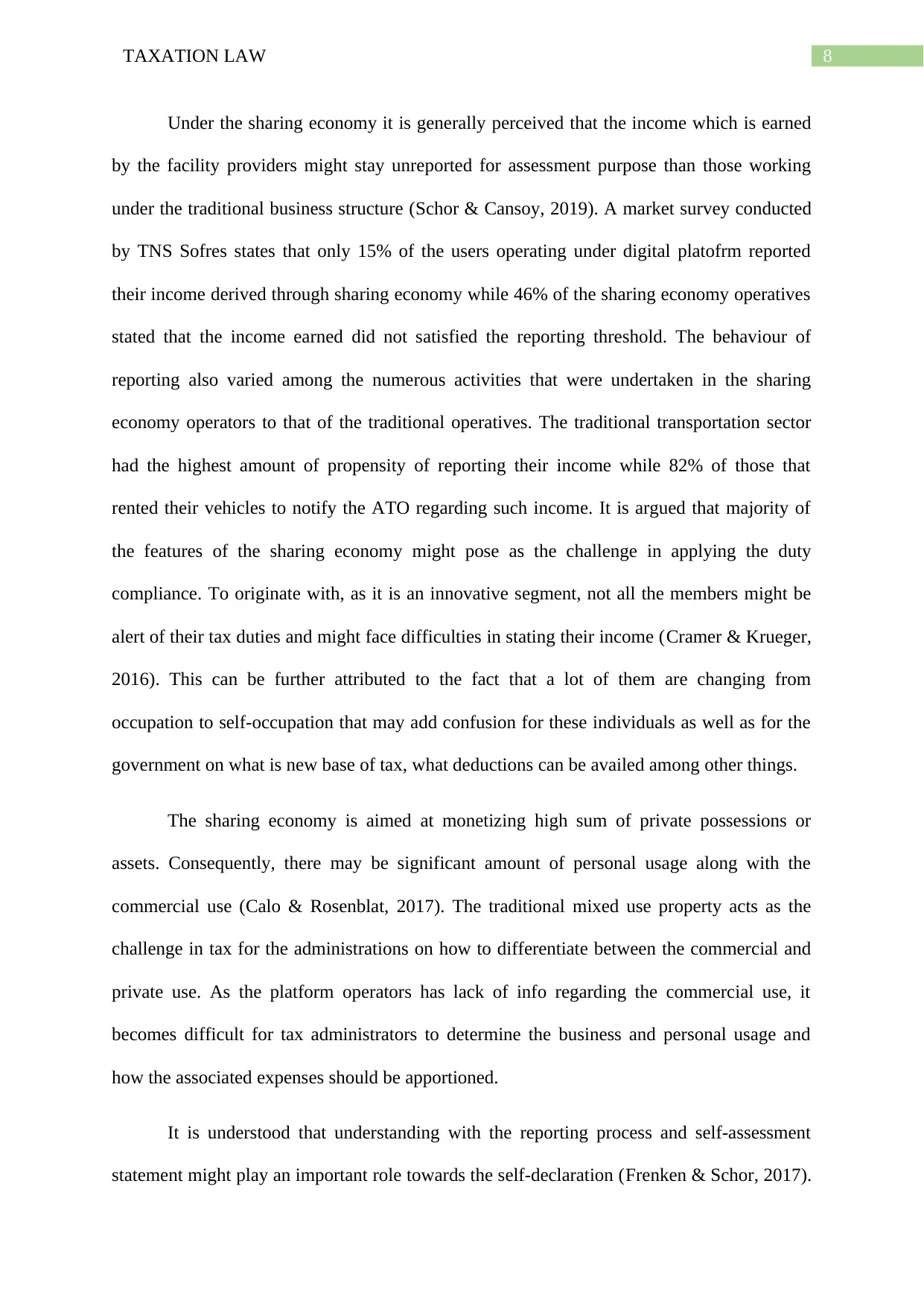
8TAXATION LAW
Under the sharing economy it is generally perceived that the income which is earned
by the facility providers might stay unreported for assessment purpose than those working
under the traditional business structure (Schor & Cansoy, 2019). A market survey conducted
by TNS Sofres states that only 15% of the users operating under digital platofrm reported
their income derived through sharing economy while 46% of the sharing economy operatives
stated that the income earned did not satisfied the reporting threshold. The behaviour of
reporting also varied among the numerous activities that were undertaken in the sharing
economy operators to that of the traditional operatives. The traditional transportation sector
had the highest amount of propensity of reporting their income while 82% of those that
rented their vehicles to notify the ATO regarding such income. It is argued that majority of
the features of the sharing economy might pose as the challenge in applying the duty
compliance. To originate with, as it is an innovative segment, not all the members might be
alert of their tax duties and might face difficulties in stating their income (Cramer & Krueger,
2016). This can be further attributed to the fact that a lot of them are changing from
occupation to self-occupation that may add confusion for these individuals as well as for the
government on what is new base of tax, what deductions can be availed among other things.
The sharing economy is aimed at monetizing high sum of private possessions or
assets. Consequently, there may be significant amount of personal usage along with the
commercial use (Calo & Rosenblat, 2017). The traditional mixed use property acts as the
challenge in tax for the administrations on how to differentiate between the commercial and
private use. As the platform operators has lack of info regarding the commercial use, it
becomes difficult for tax administrators to determine the business and personal usage and
how the associated expenses should be apportioned.
It is understood that understanding with the reporting process and self-assessment
statement might play an important role towards the self-declaration (Frenken & Schor, 2017).
Under the sharing economy it is generally perceived that the income which is earned
by the facility providers might stay unreported for assessment purpose than those working
under the traditional business structure (Schor & Cansoy, 2019). A market survey conducted
by TNS Sofres states that only 15% of the users operating under digital platofrm reported
their income derived through sharing economy while 46% of the sharing economy operatives
stated that the income earned did not satisfied the reporting threshold. The behaviour of
reporting also varied among the numerous activities that were undertaken in the sharing
economy operators to that of the traditional operatives. The traditional transportation sector
had the highest amount of propensity of reporting their income while 82% of those that
rented their vehicles to notify the ATO regarding such income. It is argued that majority of
the features of the sharing economy might pose as the challenge in applying the duty
compliance. To originate with, as it is an innovative segment, not all the members might be
alert of their tax duties and might face difficulties in stating their income (Cramer & Krueger,
2016). This can be further attributed to the fact that a lot of them are changing from
occupation to self-occupation that may add confusion for these individuals as well as for the
government on what is new base of tax, what deductions can be availed among other things.
The sharing economy is aimed at monetizing high sum of private possessions or
assets. Consequently, there may be significant amount of personal usage along with the
commercial use (Calo & Rosenblat, 2017). The traditional mixed use property acts as the
challenge in tax for the administrations on how to differentiate between the commercial and
private use. As the platform operators has lack of info regarding the commercial use, it
becomes difficult for tax administrators to determine the business and personal usage and
how the associated expenses should be apportioned.
It is understood that understanding with the reporting process and self-assessment
statement might play an important role towards the self-declaration (Frenken & Schor, 2017).
⊘ This is a preview!⊘
Do you want full access?
Subscribe today to unlock all pages.

Trusted by 1+ million students worldwide
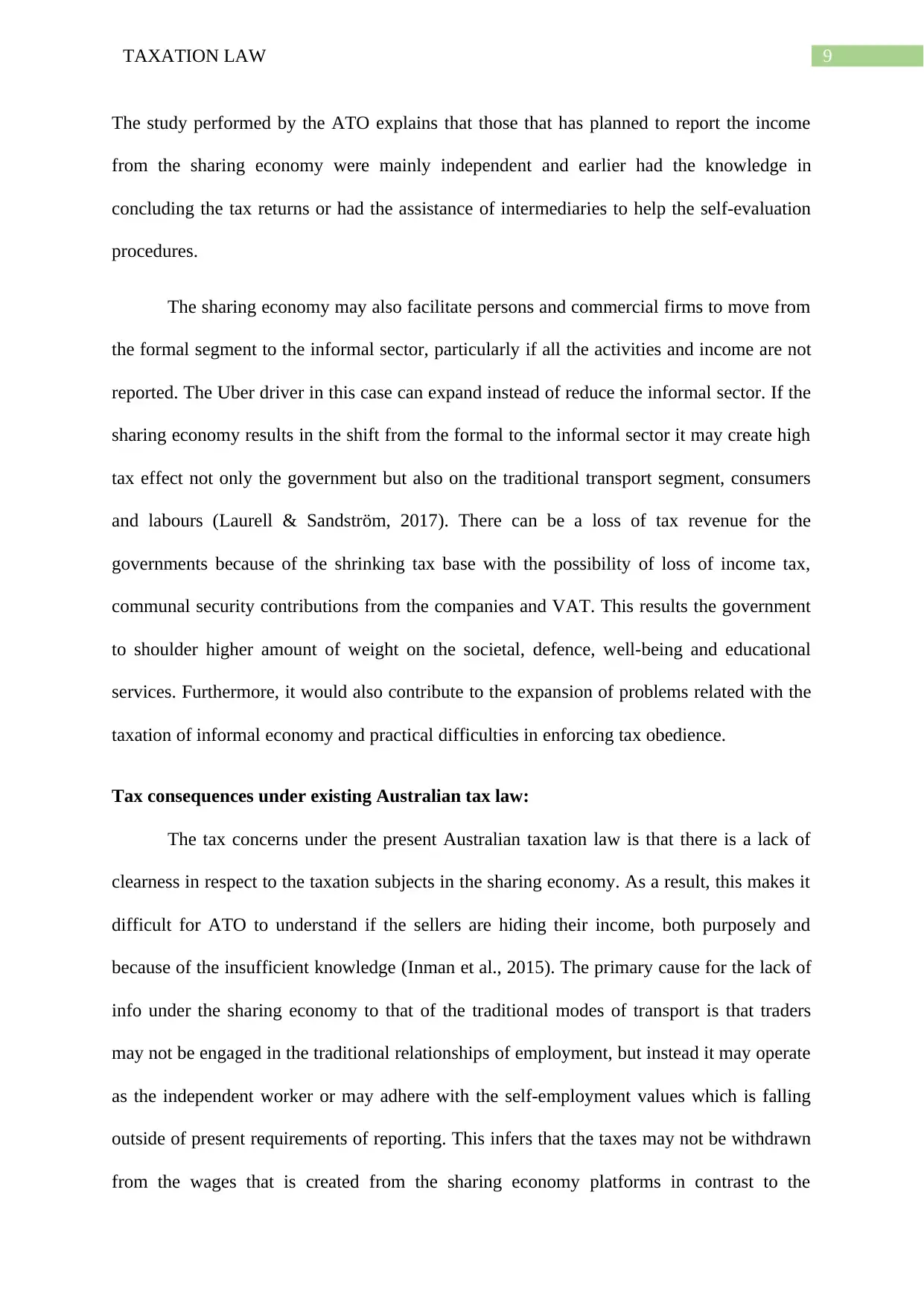
9TAXATION LAW
The study performed by the ATO explains that those that has planned to report the income
from the sharing economy were mainly independent and earlier had the knowledge in
concluding the tax returns or had the assistance of intermediaries to help the self-evaluation
procedures.
The sharing economy may also facilitate persons and commercial firms to move from
the formal segment to the informal sector, particularly if all the activities and income are not
reported. The Uber driver in this case can expand instead of reduce the informal sector. If the
sharing economy results in the shift from the formal to the informal sector it may create high
tax effect not only the government but also on the traditional transport segment, consumers
and labours (Laurell & Sandström, 2017). There can be a loss of tax revenue for the
governments because of the shrinking tax base with the possibility of loss of income tax,
communal security contributions from the companies and VAT. This results the government
to shoulder higher amount of weight on the societal, defence, well-being and educational
services. Furthermore, it would also contribute to the expansion of problems related with the
taxation of informal economy and practical difficulties in enforcing tax obedience.
Tax consequences under existing Australian tax law:
The tax concerns under the present Australian taxation law is that there is a lack of
clearness in respect to the taxation subjects in the sharing economy. As a result, this makes it
difficult for ATO to understand if the sellers are hiding their income, both purposely and
because of the insufficient knowledge (Inman et al., 2015). The primary cause for the lack of
info under the sharing economy to that of the traditional modes of transport is that traders
may not be engaged in the traditional relationships of employment, but instead it may operate
as the independent worker or may adhere with the self-employment values which is falling
outside of present requirements of reporting. This infers that the taxes may not be withdrawn
from the wages that is created from the sharing economy platforms in contrast to the
The study performed by the ATO explains that those that has planned to report the income
from the sharing economy were mainly independent and earlier had the knowledge in
concluding the tax returns or had the assistance of intermediaries to help the self-evaluation
procedures.
The sharing economy may also facilitate persons and commercial firms to move from
the formal segment to the informal sector, particularly if all the activities and income are not
reported. The Uber driver in this case can expand instead of reduce the informal sector. If the
sharing economy results in the shift from the formal to the informal sector it may create high
tax effect not only the government but also on the traditional transport segment, consumers
and labours (Laurell & Sandström, 2017). There can be a loss of tax revenue for the
governments because of the shrinking tax base with the possibility of loss of income tax,
communal security contributions from the companies and VAT. This results the government
to shoulder higher amount of weight on the societal, defence, well-being and educational
services. Furthermore, it would also contribute to the expansion of problems related with the
taxation of informal economy and practical difficulties in enforcing tax obedience.
Tax consequences under existing Australian tax law:
The tax concerns under the present Australian taxation law is that there is a lack of
clearness in respect to the taxation subjects in the sharing economy. As a result, this makes it
difficult for ATO to understand if the sellers are hiding their income, both purposely and
because of the insufficient knowledge (Inman et al., 2015). The primary cause for the lack of
info under the sharing economy to that of the traditional modes of transport is that traders
may not be engaged in the traditional relationships of employment, but instead it may operate
as the independent worker or may adhere with the self-employment values which is falling
outside of present requirements of reporting. This infers that the taxes may not be withdrawn
from the wages that is created from the sharing economy platforms in contrast to the
Paraphrase This Document
Need a fresh take? Get an instant paraphrase of this document with our AI Paraphraser
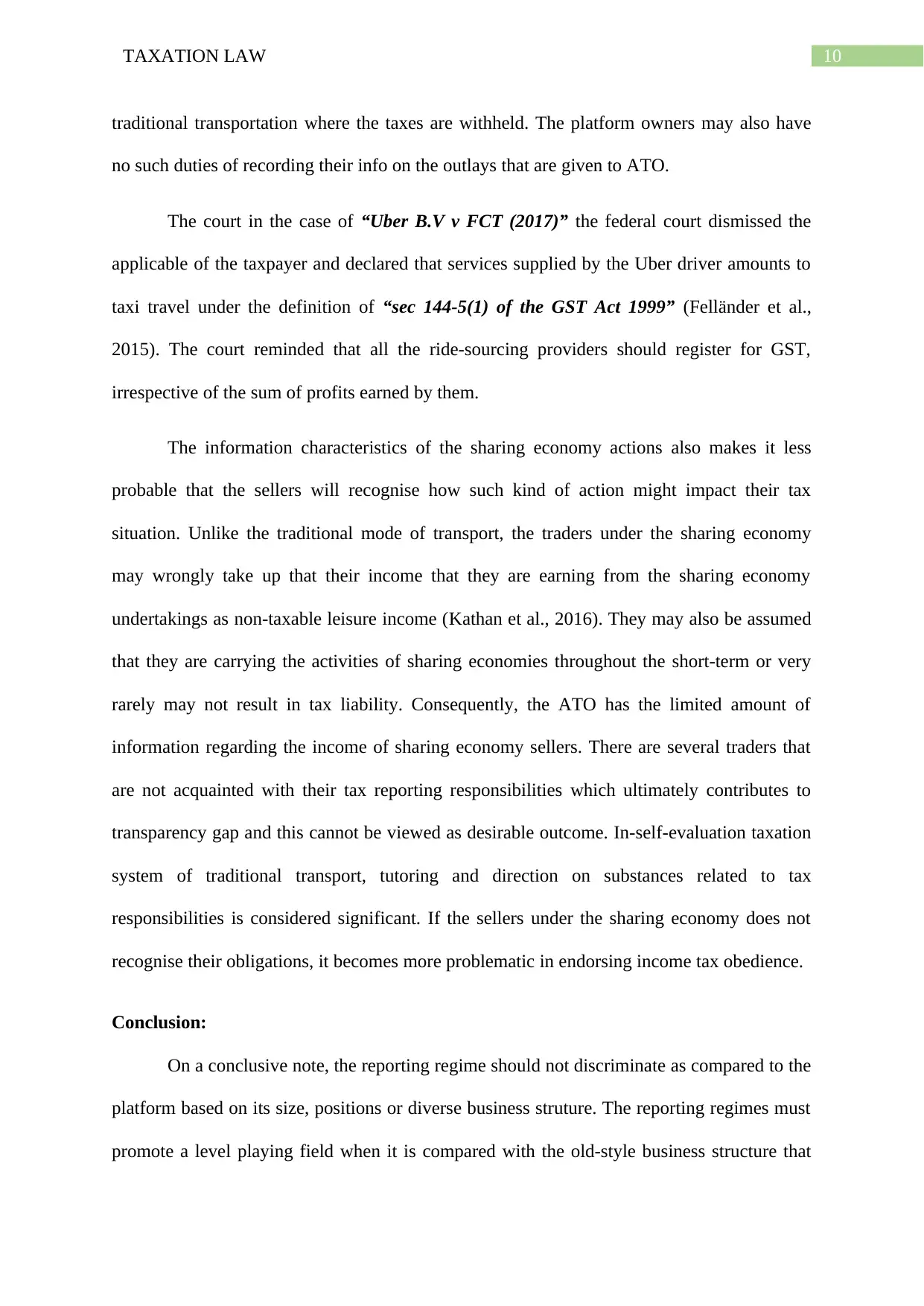
10TAXATION LAW
traditional transportation where the taxes are withheld. The platform owners may also have
no such duties of recording their info on the outlays that are given to ATO.
The court in the case of “Uber B.V v FCT (2017)” the federal court dismissed the
applicable of the taxpayer and declared that services supplied by the Uber driver amounts to
taxi travel under the definition of “sec 144-5(1) of the GST Act 1999” (Felländer et al.,
2015). The court reminded that all the ride-sourcing providers should register for GST,
irrespective of the sum of profits earned by them.
The information characteristics of the sharing economy actions also makes it less
probable that the sellers will recognise how such kind of action might impact their tax
situation. Unlike the traditional mode of transport, the traders under the sharing economy
may wrongly take up that their income that they are earning from the sharing economy
undertakings as non-taxable leisure income (Kathan et al., 2016). They may also be assumed
that they are carrying the activities of sharing economies throughout the short-term or very
rarely may not result in tax liability. Consequently, the ATO has the limited amount of
information regarding the income of sharing economy sellers. There are several traders that
are not acquainted with their tax reporting responsibilities which ultimately contributes to
transparency gap and this cannot be viewed as desirable outcome. In-self-evaluation taxation
system of traditional transport, tutoring and direction on substances related to tax
responsibilities is considered significant. If the sellers under the sharing economy does not
recognise their obligations, it becomes more problematic in endorsing income tax obedience.
Conclusion:
On a conclusive note, the reporting regime should not discriminate as compared to the
platform based on its size, positions or diverse business struture. The reporting regimes must
promote a level playing field when it is compared with the old-style business structure that
traditional transportation where the taxes are withheld. The platform owners may also have
no such duties of recording their info on the outlays that are given to ATO.
The court in the case of “Uber B.V v FCT (2017)” the federal court dismissed the
applicable of the taxpayer and declared that services supplied by the Uber driver amounts to
taxi travel under the definition of “sec 144-5(1) of the GST Act 1999” (Felländer et al.,
2015). The court reminded that all the ride-sourcing providers should register for GST,
irrespective of the sum of profits earned by them.
The information characteristics of the sharing economy actions also makes it less
probable that the sellers will recognise how such kind of action might impact their tax
situation. Unlike the traditional mode of transport, the traders under the sharing economy
may wrongly take up that their income that they are earning from the sharing economy
undertakings as non-taxable leisure income (Kathan et al., 2016). They may also be assumed
that they are carrying the activities of sharing economies throughout the short-term or very
rarely may not result in tax liability. Consequently, the ATO has the limited amount of
information regarding the income of sharing economy sellers. There are several traders that
are not acquainted with their tax reporting responsibilities which ultimately contributes to
transparency gap and this cannot be viewed as desirable outcome. In-self-evaluation taxation
system of traditional transport, tutoring and direction on substances related to tax
responsibilities is considered significant. If the sellers under the sharing economy does not
recognise their obligations, it becomes more problematic in endorsing income tax obedience.
Conclusion:
On a conclusive note, the reporting regime should not discriminate as compared to the
platform based on its size, positions or diverse business struture. The reporting regimes must
promote a level playing field when it is compared with the old-style business structure that
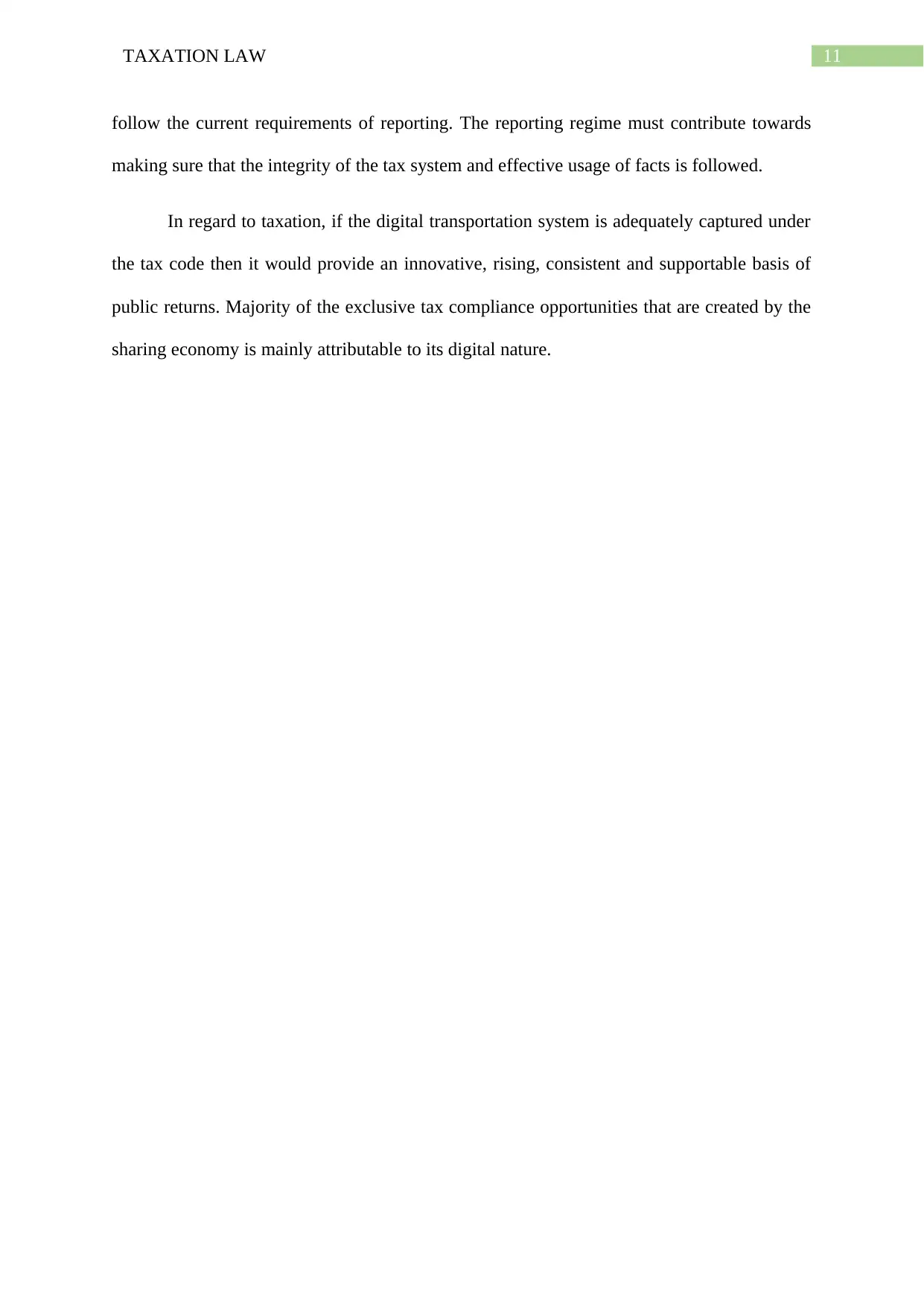
11TAXATION LAW
follow the current requirements of reporting. The reporting regime must contribute towards
making sure that the integrity of the tax system and effective usage of facts is followed.
In regard to taxation, if the digital transportation system is adequately captured under
the tax code then it would provide an innovative, rising, consistent and supportable basis of
public returns. Majority of the exclusive tax compliance opportunities that are created by the
sharing economy is mainly attributable to its digital nature.
follow the current requirements of reporting. The reporting regime must contribute towards
making sure that the integrity of the tax system and effective usage of facts is followed.
In regard to taxation, if the digital transportation system is adequately captured under
the tax code then it would provide an innovative, rising, consistent and supportable basis of
public returns. Majority of the exclusive tax compliance opportunities that are created by the
sharing economy is mainly attributable to its digital nature.
⊘ This is a preview!⊘
Do you want full access?
Subscribe today to unlock all pages.

Trusted by 1+ million students worldwide
1 out of 15
Related Documents
Your All-in-One AI-Powered Toolkit for Academic Success.
+13062052269
info@desklib.com
Available 24*7 on WhatsApp / Email
![[object Object]](/_next/static/media/star-bottom.7253800d.svg)
Unlock your academic potential
Copyright © 2020–2025 A2Z Services. All Rights Reserved. Developed and managed by ZUCOL.





